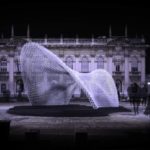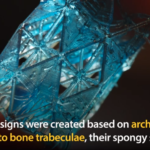News, 3D printed biomimicry of bone yields important discovery for lightweight and durable engineering
A study of a 3D-printed model has found that the structure of bones can be used to form sturdier objects and architectures. There are horizontal and vertical rods found in the bone that can degenerate and break. These rod-like and plate-like structures provide the stiffness and strength for the bone. In order to test how bone structures degenerate through time, a team from Cornell, Purdue, and Case Western Reserve University created a 3D-printed model. They ran experiments to understand its durability through compression. The study also addressed the light weight of the 3D printed model where it is economically efficient to produce and transport.
Learn about our two Decals!
 Click here to find out more about our Fall Bioinspired Design Decal and our Spring Bioinspired Design in Action Decal – ALL MAJORS are welcome.
Click here to find out more about our Fall Bioinspired Design Decal and our Spring Bioinspired Design in Action Decal – ALL MAJORS are welcome.Berkeley BioDesign Community
 Click here to learn about the BioD: Bio-Inspired Design @ Berkeley student organization or here to signup for more info.
Click here to learn about the BioD: Bio-Inspired Design @ Berkeley student organization or here to signup for more info.Search
Student Login





I imagine that the neurological circuits underlying these processes are governed by both 2d spacing maps with their brains as…
to reduce the impact of car accidents, it may be possible to study the force diverting physics of cockroaches to…
you see this type of head-bobbing stability in many avian creatures related to pigeons like chickens. the head ability to…
not like they taught horses how to run! this is an example of convergent evolution where both sea creatures and…
The brain functions in a similar way with neuronal connections. our brains are able to utilize the multiplicity of connections…